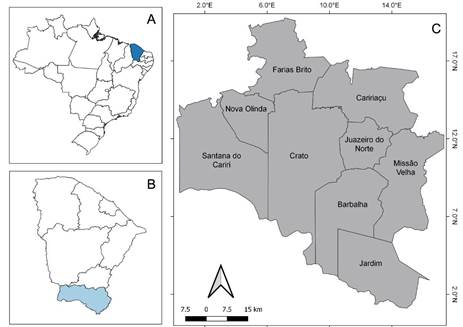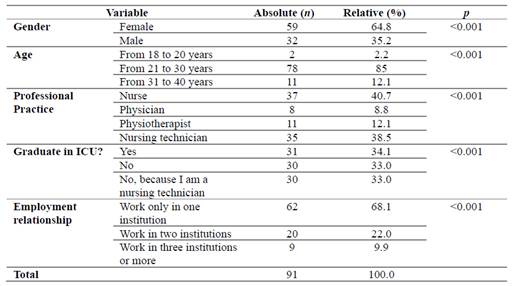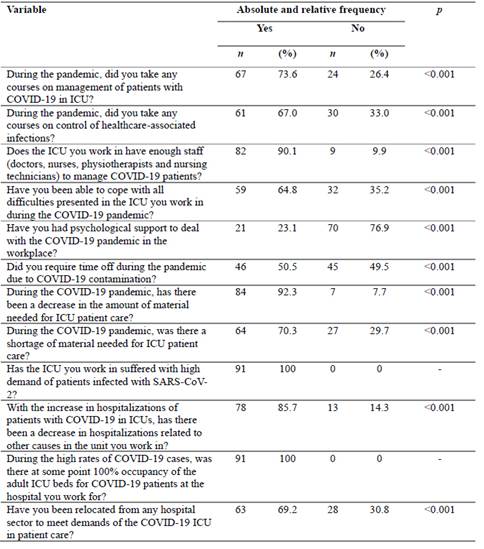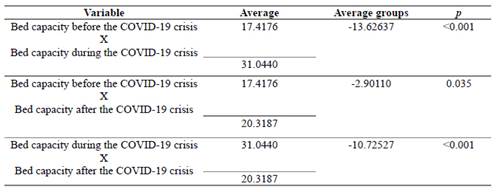Services on Demand
Journal
Article
Related links
Share
Enfermería: Cuidados Humanizados
Print version ISSN 1688-8375On-line version ISSN 2393-6606
Enfermería (Montevideo) vol.12 no.2 Montevideo 2023 Epub Dec 01, 2023
https://doi.org/10.22235/ech.v12i2.3341
Original Articles
Intensive Care Unit Resource Management in Times of the COVID-19 Pandemic
1 Universidade Regional do Cariri, Brasil, luis.reis@urca.br
2 Universidade Regional do Cariri, Brasil
3 Universidade Regional do Cariri, Brasil
4 Universidade Regional do Cariri, Brasil
Objective:
To analyze resource management aspects in intensive care units (ICU) in times of COVID-19 in Cariri microregion of Ceará
Methods:
Descriptive cross-sectional study in four hospitals in the Cariri microregion, with 91 professionals from interdisciplinary teams who have been working in the ICU since the beginning of the pandemic. Research was conducted through email, Instagram and/or WhatsApp and the data were analyzed in the chi-square test, T-test and cluster chart
Results:
Regarding human resources, 73.6 % of professionals took a course on patient management in ICU during COVID-19 and 67.0 % on control of healthcare-associated infections. Of these professionals, 64.8 % were able to deal with the difficulties in the ICU, 69.2 % were relocated from other hospital sectors to meet ICU demands and most professionals (76.9 %) did not have psychological support for the pandemic. In structural resources, 100 % of adult ICU beds were occupied during the pandemic, presenting a difference between before and during, during and after the crisis with an exponential increase in bed capacity (p<0.001), and showing no significant differences in moments before and after the pandemic (p=0.035). Material resources were in short supply and decreased, such as personal protective equipment, oxygen, medicines, among others
Conclusion:
Identifying the reorganization of human, material and structural resources was possible in the researched hospitals. There has been an exponential increase in beds during the pandemic crisis when compared to the capacity reported by staff from moments before the pandemic. Therefore, this research contributes to the knowledge of health management and hospital restructuring in pandemic times
Keywords: intensive care units; COVID-19; hospital restructuring; hospital administration; personnel management; material resource management
Objetivo:
Analisar aspectos de gestão em recursos das unidades de terapia intensiva (UTI) em tempos de COVID-19 na microrregião Cariri cearense.
Método:
Estudo descritivo do tipo transversal em quatro hospitais da microrregião do Cariri, com 91 profissionais da equipe interdisciplinar que atuam em UTI desde o início da pandemia. A pesquisa foi realizada através de e-mail, Instagram e/ou WhatsApp e os dados analisados em teste do qui-quadrado, teste-T e gráfico de clusters.
Resultados:
Acerca dos recursos humanos, 73,6 % dos profissionais realizaram curso de manejo do paciente em UTI durante a COVID-19 e 67,0 % sobre controle de infecções relacionados a serviços de saúde. Um 64,8 % conseguiram lidar como as dificuldades na UTI, 69,2 % foram remanejados de outros setores hospitalares para atender demandas da UTI e grande parte dos profissionais (76,9 %) não tiveram aporte psicológico para a pandemia. Nos recursos estruturais, 100 % dos leitos de UTI adulto foram ocupados durante a pandemia, apresentando diferença entre antes e durante, durante e após a crise com aumento exponencial da capacidade de leitos (p<0,001), e não apresentando diferenças significativas em momentos antes e após a pandemia (p=0,035). Recursos materiais estiveram em escassez e diminuição, como equipamentos de proteção individual, oxigênio, medicamentos, entre outros.
Conclusão:
Foi possível identificar a reorganização dos recursos humanos, materiais e estruturais dos hospitais da pesquisa. Houve aumento exponencial de leitos durante a crise pandêmica quando comparado a capacidade relatada pelos profissionais de momentos antes da pandemia. Portanto, esta pesquisa contribui para o conhecimento de gestão em saúde e reestruturação hospitalar em tempos de pandemia.
Palavras-chave: unidades de terapia intensiva; COVID-19; reestruturação hospitalar; administração hospitalar; gestão de recursos humanos; gestão de recursos materiais
Objetivo:
Analizar aspectos de la gestión de recursos de las unidades de cuidados intensivos (UCI) en tiempos de COVID-19 en la microrregión de Cariri, Ceará
Método:
Estudio descriptivo transversal en cuatro hospitales de la microrregión de Cariri, con 91 profesionales del equipo interdisciplinario que trabajan en UCI desde el inicio de la pandemia. La encuesta se realizó por correo electrónico, Instagram y/o WhatsApp y los datos se analizaron mediante la prueba chi-cuadrado, prueba T y gráfico de conglomerados
Resultados:
Respecto a los recursos humanos, el 73.6 % de los profesionales realizó un curso de manejo de pacientes en UCI durante la COVID-19 y el 67.0 % sobre control de infecciones relacionadas con los servicios sanitarios. El 64.8 % pudo hacer frente a las dificultades en la UCI, el 69,2 % fue reasignado de otros sectores hospitalarios para atender las demandas de la UCI y la mayoría de los profesionales (76.9 %) no tuvo apoyo psicológico para la pandemia. En cuanto a los recursos organizativos, el 100 % de las camas de la UCI de adultos estuvieron ocupadas durante la pandemia, con una diferencia entre antes y durante, durante y después de la crisis, con un aumento exponencial de la capacidad de camas (p<0,001), y sin diferencias significativas entre antes y después de la pandemia (p=0,035). Los recursos materiales escasearon y disminuyeron, como equipos de protección personal, oxígeno, medicamentos, entre otros
Conclusión:
Se pudo identificar la gestión de los recursos humanos, materiales y organizativos en los hospitales encuestados. Hubo un aumento exponencial de camas durante la crisis pandémica en comparación con la capacidad reportada por los profesionales antes de la pandemia. Por lo tanto, esta investigación contribuye al conocimiento de la gestión sanitaria y la reestructuración hospitalaria en tiempos de pandemia
Palabras clave: unidades de cuidados intensivos; COVID-19; reestructuración hospitalaria; administración hospitalaria; gestión de recursos humanos; gestión de recursos materiales
Introduction
COVID-19, first identified in China in 2019, is a disease capable of affecting several systems, including the respiratory system, with rapid evolution of contagion. (1 It was observed viral infection had a self-power of lethality and similarity to the viruses responsible for Severe Acute Respiratory Syndrome (SARS) and Middle East Respiratory Syndrome (MERS). Soon with the increase in cases, a pandemic was decreed and a large portion of the world population was infected by this virus. 2
According to the World Health Organization, in February 2023, the global number of deaths caused by this disease reached 6,870,013, while in Brazil 698,928 thousand deaths and 37,020,531 million cases of infection were reported. 3
The novel coronavirus pandemic has brought devastating consequences for humanity. It generated a high emergency demand to the Unified Health System (Sistema Único de Saúde - SUS), with economic and social impact, causing one of the most serious Brazilian health crises. Spread speed of the virus limited the process of patient care, generating an imbalance in demands for hospitalizations and hospital care. 4
Studies conducted in China indicate new hospitals and beds coverage for the high patient’ demand occurred in a few days, due to the country’s great technological development and government support. 5 Contrary to Brazil, where several health units did not have technological and structural contribution to assist high daily demand, because historically Brazilian hospital care structure is insufficient. These factors negatively influenced reorganization and management of human, material and structural resources of hospitals in COVID-19 pandemic outbreak in Brazil. 6
Construction of new units necessary for caring of patients with COVID-19 also required new flow access organization, such as demands for equipment, ventilators, an extensive medical gas network that support demand, adequate instruments quantity and quality and, especially, professional workforce of those who work hard in care context. 7
The Intensive Care Unit (ICU) was one hospital sector that underwent reorganization and flows’ division. Most hospitalized patients, mainly elderly, in outpatient clinics and medical clinics, drastically changed their health status, requiring precise monitoring and ICU admission. 8
Considering this collapse in Brazilian public health and the difficulty in managing COVID-19, this work comes from the perspective of analyzing reorganization in ICUs at reference hospitals in the Cariri region, as well as management aspects regarding human, material and structural resources for care of individuals with COVID-19. Therefore, the aim of this research was to analyze management aspects in ICU resources in times of COVID-19 in Cariri microregion of Ceará.
Method
This is a descriptive quantitative cross-sectional study, developed through data collection and analysis according to the Strengthening the Reporting of Observational Studies in Epidemiology guidelines (STROBE). 9
Research was carried out in the south of Ceará, a region called Cariri. This region includes about nine municipalities (Figure 1), but there are three central cities: Crato, Juazeiro do Norte and Barbalha. Therefore, the junction of these three cities is called Cariri microregion, which serves most health sectors and includes structured hospitals and various specialties, concentrating demands from all surrounding cities.
Research focused on four hospitals in microregion, one large and three medium or small. Study population was composed of health professionals who worked before, during and after the COVID-19 pandemic, being one of the professional categories: doctors, nurses, nursing technicians and physiotherapists. Sample was calculated based on the formula for calculating a finite population. Therefore, adopting a confidence coefficient of 95 %, and maximum allowable error of 5 %, accounting for a sample size of 91 health professionals.
To answer the questionnaire, participants’ eligibility aspects were evaluated, which were, inclusion criteria: to be exercising function of nurse, physician, physiotherapist or nursing technician, working in an adult ICU in one of the four hospitals researched since the period of occurrence of COVID-19 first cases in Cariri region. Exclusion criteria: having been fired or furloughed for more than a month, hired or rehired during and/or after pandemic crisis, and not having access to the internet.
Research was applied through Google Forms between the months of December 2022 to February 2023, sent through email, Instagram or WhatsApp of the ICUs interdisciplinary team. A screening process was carried out to participate in research, with resistance from some eligible individuals to answer the study.
Regarding the screening process, this was carried out in professionals’ identification through indication of those who cooperated and answered the survey, recommending emails, Instagram or WhatsApp of individuals who possibly met inclusion and exclusion criteria.
Therefore, initially possible participants were identified, an invitation letter was sent introducing researchers’ team and talking about the research importance. To those who returned contact, the Free and Informed Consent (IC) was subsequently sent to be signed online and the research form, containing sociodemographic and specific questions about resource management of the ICUs in which they work, in total 22 questions contemplated the form. When answering the survey, participants shared social media of co-workers who were possibly eligible for this study, which was later evaluated by the researchers. The study was shared on Instagram through ads directed to professionals to identify eligibility criteria for the research, therefore intentional sample, with data collection using the Snowball technique.
For data analysis, descriptive and inferential statistics were used. Categorical variables were expressed as absolute and relative frequencies and numerical variables as dispersion measures (means). Paired Sample T-test was performed. A clustered bar chart was adopted for graphical analysis, which helps to visualize quickly and simply similarities between groups or elements. Chi-square test or Fisher’s exact test was performed to verify associations between study variables. These analyses were performed with the software Statistical Package Social Sciences (SPSS). A significance level of p ≤0.05 was adopted for the study.
Study complied with Resolution No. 466/2012 norms, and was approved by the Ethics and Research Committee of the Universidade Regional do Cariri (Regional University of Cariri) in 2022, according to CAAE: 64917722.0.0000.5055 and opinion number 5,788,585.
Results
Study included 91 health professionals from ICUs of Cariri microregion of Ceará who met eligibility criteria. Of these, 64.8 % were female and 35.2 % were male, with a prevalent age range of 21 to 30 years (85 %). Regarding professional function, 40.7 % held the position of nurse, 38.5 % nursing technicians, 12.1 %, physiotherapists, 8.8 % physicians. When asked about ICU graduate studies, 34.1 % of these professionals confirmed “yes” to having specialization, 33.0 % said “no” and 33.0 % said “no, because I am a nursing technician”. Divergence of data was found between professional performance in nursing technicians, correlated with level of post-graduation, it is justified by the fact that there are still trained and specialized nursing professionals, who also have technicians training and still occupy this position. Regarding employment relationships, 68.1 % reported working only in one institution, 22.0 % said they worked in two institutions and 9.9 % worked in three or more institutions. T1
Many professionals worked in two or three hospitals during the pandemic interval, therefore, they were requested to fill out the questionnaire considering one of the hospitals they work, so it maintains reliability on aspects and human, material and structural resources researched. Table 2 shows human resources aspects which include permanent education, psycho-emotional and/or health and work relationships during COVID-19. Aspects of material resources, such as lack and scarcity of material for work. Structural resources, presenting units overcrowding and professional relocation to align demands created by COVID-19.
Permanent education was highlighted when asked if they took a course for management of patients with COVID-19 in the ICU (73.6 %) and if they took a course on control of healthcare-associated infection (67.0 %), concerning working conditions they were asked if in the ICU has enough staff to manage the crisis (90.1 %). Psychoemotional and health relationship were evaluated when questioning about ability to deal with difficulties presented in ICU during the COVID-19 pandemic (64.8 %), if they had psychological support to deal with the pandemic in their workplace (23.1 %) and if they required leave during the pandemic due to contamination with the virus (50.5 %). When asked about materials needed to care for patients with COVID-19 in ICU, 92.3 % stated there was a decrease and 70.3 % scarcity.
Service overcrowding with patients infected with SARS-CoV-2 was strongly highlighted (100 %) as well as occupation of 100 % of ICU beds in pandemic crisis (100 %), correlating decrease in ICU’ hospitalizations related to other causes (85.7 %) and of professionals relocated from other sectors to meet ICU demands (69.2 %).
For a better understanding of the professionals’ responses affirming material resources decrease and scarcity, they were directed to answer multiple-choice questions on which of these ICU essential elements were in decrease and in scarcity for care of the patient with COVID-19. The list of material resources questioned showed medicines and Personal Protective Equipment (PPE) were in higher decrease and scarcity averages in the region of Cariri, Ceará, followed by other materials also necessary for assistance in pandemic crisis, as illustrated in Figure 2.
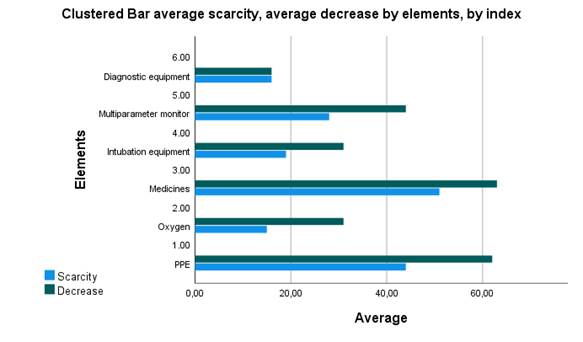
Figure 2: Average decrease and scarcity of ICU resources in the Cariri, Ceará microregion. Crato, Ceará, Brazil, 2023
Bed capacity in ICU was compared at times before, during and after the COVID-19 pandemic crisis. In the comparisons, it is possible to observe significant differences between before and during the crisis with mean (-13.62637), as well as between during and after the crisis with mean (-10.72527). Comparison of moments before and after the crisis showed no significant difference (p=0.035). Therefore, comparisons’ results show there has been an exponential increase in ICU beds in Cariri microregion to meet demands of COVID-19 patients and that ICU capacity is returning to the pre-pandemic number of beds. T3
Discussion
Thus, data point to management aspects in three dimensions: human, material and structural resources. Also, researched hospitals have had to restructure and structure their resources to meet the high demand needed due to COVID-19. Both professionals and patients have suffered serious consequences, from lack of psychological support to deal with the COVID-19 pandemic in the workplace to scarcity and decrease of materials needed in care, such as PPE, medicines and other equipment necessary to maintain the patient’s life in ICU. In addition, there are no previous studies in the Cariri region of Ceará pointing out dimensions presented in this research.
Through this study an important data about the nursing team was observed and it is valuable to start the discussion with it. There is data divergence between professional performance in nursing technicians, correlated with their post-graduation level. In Brazil, the nursing team goes through several challenges, from lack of monetary recognition to terrible working conditions. To observe nursing professionals with specializations in several areas working in their primary training as nursing technicians is still common. 10 This Brazilian reality demonstrates lack of opportunity in positions and careers, as well as the professional devaluation these individuals suffer in their work units. 11
Regarding permanent education in health, it is up to the health units to train and update professionals for better service delivery. At the beginning of the pandemic, there was great difficulty in management of the disease as well as of the sick patient, because it was an unknown virus, aspects such as prevention, contagion, morbidity and lethality were uncertain, causing panic among professionals. 12 A study conducted in India 13 points out, as a training strategy of the ICU professional team, in times of pandemic, to direct leadership roles to those who present expertise and master management of patients infected with the virus. Thus, the teaching-learning process occurred favorably in practice among professionals, preventing occurrence of errors in care, cross-infections, contamination and errors in handling of some equipment, and consequently, provided patient safety.
Education strategies also favor infections’ prevention by the professionals, guaranteeing worker safety and continuity of the service exercised. 14 This study points to a considerable number of professionals who have had to leave during the COVID-19 pandemic (50.5 %). When it comes to lack of a professional in the workplace, it affects the entire team and overloads professionals, which in a linear way reflects on patient care. So, the problem multiplies when it comes to a health crisis such as the pandemic. 15
Work overload, exhausting routines, impaired sleep and stress were factors responsible for physical and mental illness during the pandemic. However, uncertainty, fear of infecting family members and resource scarcity, such as PPE, also present on a large scale in studies, as damages in mental health. (13,16, 17, 18, 19) In the same perspective, in this research, health professionals suffered from high demand of COVID-19 and 76.9 % pointed out they did not have emotional support to deal with problems generated by the pandemic.
Material resources enable proper unit functioning and provision of quality services. These are also necessary for worker safety, reducing risks exposure in environments, and also protecting the patient. 20 This research, therefore, pointed to a proportional decrease in PPE and also in medicines, presenting a large-scale shortage during the pandemic. Among other equipment presented were multiparameter monitors, diagnostic equipment, oxygen and intubation equipment. These same elements presented scarcity according to a study conducted in a hospital in France, 19 which required going through a restructuring process transforming a hospital restaurant into a 43-bed ward for care of critically ill patients in COVID-19. Authors point out they have adopted strategies for acquisition of materials in scarcity with other more economically developed countries.
Bed management and structural capacity increase was another significant point in this research, in the results it was observed the occupation of 100 % of beds in Cariri, Ceará microregion, pointing on average to an exponential increase in its capacity when compared statistics with moments before the pandemic crisis. Identifying with new studies how these new beds were allocated is appropriate. Research conducted in a hospital in Spain, 17 points out the adequacy of new 103 ICU beds in operating rooms were organized to meet demands of critical patients.
Comparisons presented during this discussion with international realities indicate there were also needs, scarcity, decrease and readjustment of resources to meet demands of COVID-19 health crisis in other countries. However, historically, Brazilian hospitals have suffered from insufficient structures and overcrowding services, a scenario intensified during the pandemic by SARS-CoV-2. The number of deaths compared to other countries with the same inhabitants’ proportion shows lack of technological contribution and structure for these emergency demands. 21
Ecological research with Brazilian secondary data points to high cases of mortality due to lack of ICU resources during COVID-19. Among the five Brazilian regions, the most affected were Northeast, Southeast and South. 22 This research was conducted in the Northeast, Sertão of Ceará, a region with one of the lowest Human Development Index (HDI) compared to other regions in Brazil.
However, despite challenges, the state of Ceará was one of the pioneers in developing strategies to save lives during the pandemic. The Elmo is a technology adaptation created in Ceará, fundamental to avoid patients’ intubation. Several studies were developed during the pandemic using the Elmo and results showed a reduction of about 60 % in need for hospitalizations of patients severely affected by COVID-19, in ICU beds, being a strategy to reduce hospital demands. 23,24
Limitations of this research are the collection technique being online, which made it impossible for people without internet access to answer the questionnaire, as well as generated resistance among professionals to participate. Eligibility criteria also excluded many professionals, since one of the key points of this study was to analyze occupancy of beds before, during and after the pandemic crisis, so there was a need to retain professionals who assisted the entire restructuring process.
Conclusion
This study made it possible to analyze aspects in management of human, material and structural resources of ICUs in COVID-19 times in the Cariri, Ceará microregion. It was possible to conclude most professionals took a course in patient management and infection control during the pandemic, ICUs had sufficient interprofessional staff, but did not have psychological support to deal with COVID-19 pandemic in workplace and more than half of professionals required leave during the pandemic due to contamination with the virus.
There was a high decrease and scarcity of materials, highlighting medicines and PPE as most cited, it is worth mentioning 100 % of adult ICU beds reached their maximum capacity during COVID-19 and there was a decrease in hospitalizations related to other causes, with a large part of professionals relocated from other sectors to meet demands of the COVID-19 ICU. It was still possible to identify an exponential increase in beds during the pandemic crisis when compared to capacity reported by professionals from moments before the pandemic.
Therefore, this research contributes to knowledge of health management by demonstrating vivid aspects of reality in the south Sertão of Ceará. Further research should be carried out, identifying how there was structural management of units as a whole, which sectors were interrupted and where beds showing an increase were established. In Brazil’s view, it is up to development of decision-making flowcharts for situations of biological disasters, providing an early preparation of managers to these moments.
REFERENCES
1. De Albuquerque, TR, Macedo, LFR, Oliveira, EG, Rolim Neto, MR, Menezes, IRA. Vaccination for COVID-19 in children: Denialism or misinformation? Journal of Pediatric Nursing: Nursing Care of Children and Families. 2022;64:141-142. doi: 10.1016/J.PEDN.2022.01.015 [ Links ]
2. Ferraz, JAC, Zanin, L, Oliveira, AMG, Flório, FM. Prevalência e fatores associados à síndrome de burnout em profissionais da saúde indígena no Brasil. Cien Saude Colet. ABRASCO - Associação Brasileira de Saúde Coletiva. 2023;28(1):93-106. doi: 10.1590/1413-81232023281.09272022 [ Links ]
3. OMS. Organização Pan-Americana da Saúde (Internet). 2023. Coronavirus - OPAS/OMS (acesso em 2023 fev 27). Disponível em: Disponível em: https://www.paho.org/pt/topicos/coronavirusadgroupsurvey={adgroupsurvey}&gclid=Cj0KCQiA6fafBhC1ARIsAIJjL8kKhbFQcDSvD6R5fHTvqGSlEDQYBlHmcPC9cLMTEPgZemCEkimGUOAaAmxdEALw_wcB? [ Links ]
4. Pedrosa, NL, de Albuquerque, NLS. Spatial analysis of COVID-19 cases and intensive care beds in the state of Ceará, Brazil. Ciencia e Saude Coletiva. 2020;25(supl. 1):2461-2468. doi: 10.1590/1413-81232020256.1.10952020 [ Links ]
5. Zhang, H, Yin, TY, Qin, RY. Challenges and Measures in Prevention of Nosocomial Infection of COVID-19 During Resumption of Work: Experience from a Pancreatic Surgery Department, Wuhan, China. Br J Surg. 2020;107(11):e484. doi: 10.1002/BJS.11943 [ Links ]
6. Roster, KO, Martinelli, T, Connaughton, C, Santillana, M, Rodrigues, F. Estimating the impact of the COVID-19 pandemic on dengue in Brazil. Res Sq (Preprint). 2023 Feb 9:rs.3.rs-2548491. doi: 10.21203/rs.3.rs-2548491/v1. PMID: 36798282; PMCID: PMC9934738 [ Links ]
7. Campos, FCC, Canabrava, CM. O Brasil na UTI: atenção hospitalar em tempos de pandemia. Saúde em Debate. 2020;44(spe4):146-160. doi: 10.1590/0103-11042020e409 [ Links ]
8. Pereira, EF. A pandemia de Covid-19 na UTI. Horizontes Antropológicos. 2021;27(59):49-70. doi: 10.1590/s0104-71832021000100003 [ Links ]
9. Malta, M, Cardoso, LO, Bastos, FI, Magnanini, MMF, da Silva, CMFP. STROBE initiative: guidelines on reporting observational studies. Rev Saude Publica. 2010;44(3):559-565. doi: 10.1590/S0034-89102010000300021 [ Links ]
10. Marques, RC, Silveira, AJT. The enfermeiro-mor (head-nurse) in Santas Casas in the province of Minas Gerais: between care and administration. Cien Saude Colet. 2022;27(9):3419-3428. doi: 10.1590/1413-81232022279.04652022 [ Links ]
11. Alvarenga, JPO, Costa, LD, Andrade, NF, Leandro, SF, Soares, NS, Jesus, EA, et al. Pesquisar em enfermagem no contexto de luta pela valorização profissional e vivência da crise sanitária da COVID-19. Tempus (Brasília). 2023;16(4):11-23. doi: 10.18569/TEMPUS.V16I4.3097 [ Links ]
12. Menon, GR, Yadav, J, Aggarwal, S, Singh, R, Kaur, S, Chakma, T, et al. Psychological distress and burnout among healthcare worker during COVID-19 pandemic in India. A cross-sectional study. PLoS One. 2022;17(3 March). doi: 10.1371/journal.pone.0264956 [ Links ]
13. Shaparin, N, Mann, GE, Streiff, A, Kiyatkin, ME, Choice, C, Ramachandran, S, et al. Adaptation and restructuring of an academic anesthesiology department during the COVID-19 pandemic in New York City: Challenges and lessons learned. Best Pract Res Clin Anaesthesiol. 2021;35(3):425-435. doi: 10.1016/J.BPA.2020.12.010 [ Links ]
14. do Prado, PR, Ventura, CAA, Rigotti, AR, Reis, RK, Zamarioli, CM, de Souza, FB, et al. Vinculando a segurança do profissional à segurança do paciente: recomendações e questões bioéticas para o cuidado de pacientes na pandemia da COVID-19. Texto & Contexto - Enfermagem. 2021;30:e20200535. doi: 10.1590/1980-265X-TCE-2020-0535 [ Links ]
15. Silva, FI, Rodrigues, PCF, Teixeira, RAG, Oliveira, ESF de. Análise do gerenciamento de tecnologias em equipamentos médico-assistenciais em unidades de terapia intensiva: desafios para o enfrentamento da COVID-19 . Vigil sanit debate (Internet). 2022 (acesso em 2022 jul 1);10(2):13-22. Disponível em: Disponível em: https://pesquisa.bvsalud.org/portal/resource/pt/biblio-1371166 [ Links ]
16. Nunez-Villaveiran, T, González-Castro, A, Nevado-Losada, E, García-De-Lorenzo, A, Garro, P. All for One and One for All: Voluntary Physicians in the Intensive Medicine Units During the COVID-19 Outbreak in Spain. Disaster Med Public Health Prep. 2020; 16(2):612-618. doi: 10.1017/DMP.2020.375 [ Links ]
17. Vilallonga, R, Garcia Ruiz de Gordejuela, A, Cossio-Gil, Y, Domínguez González, JM, Martín Sánchez, R, Armengol Carrasco, M. Transforming a surgical department during the outbreak of new coronavirus pandemic. Clinical implications. Langenbecks Arch Surg. 2020;405(6):867-875. doi: 10.1007/S00423-020-01931-X [ Links ]
18. Singh, S, Ambooken, GC, Setlur, R, Paul, SK, Kanitkar, M, Singh Bhatia, S, et al. Challenges faced in establishing a dedicated 250 bed COVID-19 intensive care unit in a temporary structure. Trends in Anaesthesia and Critical Care. 2021;36:9-16. doi: 10.1016/J.TACC.2020.10.006 [ Links ]
19. Borel, M, Lhermite, P, Fleury, N, Ruder, MA, Fazilleau, C, Boudon, E, et al. Transformation of a hospital restaurant into an orientation intensive care unit. Annales Francaises de Medecine d’Urgence. 2021;11(4):221-233. doi: 10.3166/AFMU-2021-0344 [ Links ]
20. de Oliveira, NC, Chaves, LDP. Gerenciamento de recursos materiais: o papel da enfermeira de unidade de terapia intensiva. Revista da Rede de Enfermagem do Nordeste (Internet). 2009 (acesso em 2022 jul 11);10:19-27. Disponível em: Disponível em: http://www.redalyc.org/articulo.oa?id=324027968002 [ Links ]
21. OPAS. Organização Pan-Americana da Saúde (Internet). 2022. Excesso de mortalidade associado à pandemia de COVID-19 foi de 14,9 milhões em 2020 e 2021 (acesso em 2023 abr 9). Disponível em: Disponível em: https://www.paho.org/pt/noticias/5-5-2022-excesso-mortalidade-associado-pandemia-covid-19-foi-149-milhoes-em-2020-e-2021 [ Links ]
22. Da Silveira Moreira, R. COVID-19: unidades de terapia intensiva, ventiladores mecânicos e perfis latentes de mortalidade associados à letalidade no Brasil. Cad Saude Publica. 2020;36(5):e00080020. doi: 10.1590/0102-311X00080020 [ Links ]
23. Governo do Estado do Ceará. Secretaria da Saúde do Ceará (Internet). 2020. Criado no Ceará, capacete Elmo reduz em 60% necessidade de internação em leitos de UTI (acesso em 2023 abr 9). Disponível em: Disponível em: https://www.saude.ce.gov.br/2020/11/05/criado-no-ceara-capacete-elmo-recupera-pacientes-com-covid-19-e-reduz-em-60-necessidade-de-internacao-em-uti/ [ Links ]
24. Holanda, MA, Tomaz, BS, de Menezes, DGA, Lino, JA, Gomes, GC. Elmo 1.0: A helmet interface for cpap and high-flow oxygen delivery. Jornal Brasileiro de Pneumologia. 2021;47(3). doi: 10.36416/1806-3756/E20200590 [ Links ]
How to cite: Reis Macedo LF, Lisboa KWDSC, Pinto SDL, de Beltrão ICSL. Intensive Care Unit Resource Management in Times of the COVID-19 Pandemic. Enfermería: Cuidados Humanizados. 2023;12(2):e3341. doi: 10.22235/ech.v12i2.3341
Authors’ participation: a) Conception and design of the work; b) Data acquisition; c) Analysis and interpretation of data; d) Writing of the manuscript; e) Critical review of the manuscript. L. F. R. M. has contributed in b, c, d; K. W. D. S. C. L. in a, c, e; S. D. L. P. in a, d, e; I. C. S. L. D. B. in d, e.
Received: May 06, 2023; Accepted: September 21, 2023











 text in
text in 


